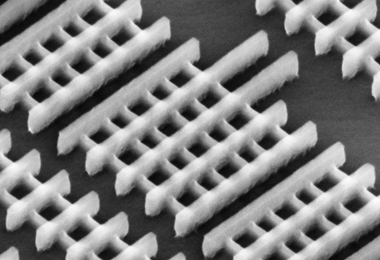Intel Makes 22nm 3-D Tri-Gate Tech for Ivy Bridge
Moore's Law continues.
Intel Corporation today announced transistors using a three-dimensional structure will be put into high-volume manufacturing. Intel introduced a revolutionary 3-D transistor design called Tri-Gate, first disclosed by Intel in 2002, into high-volume manufacturing at the 22-nanometer node in Ivy Bridge.
The company qualified 3-D Tri-Gate transistors as a reinvention of the transistor. The traditional "flat" two-dimensional planar gate is replaced with an incredibly thin three-dimensional silicon fin that rises up vertically from the silicon substrate. Control of current is accomplished by implementing a gate on each of the three sides of the fin – two on each side and one across the top – rather than just one on top, as is the case with the 2-D planar transistor. The additional control enables as much transistor current flowing as possible when the transistor is in the "on" state (for performance), and as close to zero as possible when it is in the "off" state (to minimize power), and enables the transistor to switch very quickly between the two states (again, for performance).
Check out this video below for a visual aid.
Since these fins are vertical in nature, transistors can be packed closer together, a critical component to the technological and economic benefits of Moore's Law. Intel also points out that, for future generations, designers also have the ability to continue growing the height of the fins to get even more performance and energy-efficiency gains.
Intel's 3-D Tri-Gate transistors enable chips to operate at lower voltage with lower leakage, providing improved performance and energy efficiency compared to previous state-of-the-art transistors. The capabilities give chip designers the flexibility to choose transistors targeted for low power or high performance, depending on the application.
According to Intel's numbers, the 22nm 3-D Tri-Gate transistors provide up to 37 percent performance increase at low voltage versus Intel's 32nm planar 2-D transistors. Alternatively, the new transistors consume less than half the power when at the same performance as 2-D planar transistors on 32nm chips.
"For years we have seen limits to how small transistors can get," said Intel co-founder Gordon Moore. "This change in the basic structure is a truly revolutionary approach, and one that should allow Moore's Law, and the historic pace of innovation, to continue."
Get Tom's Hardware's best news and in-depth reviews, straight to your inbox.
Today, Intel demonstrated the world's first 22nm microprocessor, codenamed "Ivy Bridge," working in a laptop, server and desktop computer. Ivy Bridge-based Core family processors will be the first high-volume chips to use 3-D Tri-Gate transistors. Ivy Bridge is slated for high-volume production readiness by the end of this year.
-
burnley14 I guess this is the "something revolutionary" Intel was promising for Ivy Bridge. Definitely revolutionary, I'm impressed.Reply -
really puts the sting on amd. people were wondering if bulldozer could hold up to sandy bridge, but unless they plan on something huge, it doesn't seem like they will be able to keep up with intel. i guess that means amd fans could maybe look forward to inexpensive pricing.Reply
-
ellarpc AMD will just go ARMstrong and leave Intel with the dying x86... Or yeah AMD prolly won't be able to compete with IntelReply -
ben850 As long as AMD's CPU's can still support the latest games and applications, I'll continue to buy them.Reply
Competition is required for innovation in this market..


